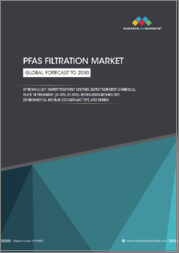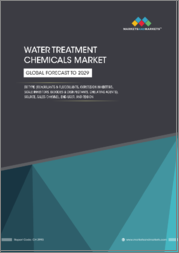
|
시장보고서
상품코드
1513575
조류 처리제 시장 규모 : 조류 유형별, 제품 유형별, 최종 사용 산업별, 예측(2024-2032년)Algae Treatment Chemical Market Size - By Algae Type (Green algae, Blue-green algae, Diatoms, Red algae, Others), By Product Type (Algaecides, Algistats, Flocculants & coagulants, pH adjusters), By End-Use Industry & Forecast, 2024 - 2032 |
||||||
조류 처리제 시장 규모는 2024년부터 2032년까지 연평균 5.4% 이상의 성장률을 기록할 것으로 예상되며, 이는 다양한 산업 분야에서 지속가능한 물 관리에 대한 인식과 실천에 대한 인식이 높아진 것이 원동력이 되고 있습니다.
물 부족과 오염이 전 세계적으로 큰 문제가 되고 있는 가운데, 농업, 양식업, 수처리 플랜트 등의 업계에서는 조류의 번식을 방지하는 동시에 효율적이고 친환경적인 방법을 채택하고 있습니다. 따라서 조류 처리는 수생 생태계에 해를 끼치고 물 공급을 위협하며 처리 비용을 증가시키는 조류의 대량 발생을 예방하고 관리하는 데 있어 중요한 역할을 하고 있습니다. 예를 들어, 2023년 4월 Green Water Labs는 조류의 번식을 방지하고 제거하여 사람과 동물, 환경에 안전하게 사용할 수 있는 조류 방제제를 출시하였습니다.
조류 처리 기술의 발전과 보다 효과적인 화학 제제의 시장 개척도 시장 성장에 영향을 미칠 것으로 보입니다. 생분해성 무해한 화학제품과 같은 조류 제거 제품의 혁신은 환경에 미치는 영향이 적고 효율적이기 때문에 인기를 끌고 있습니다. 특정 조류를 대상으로 하는 맞춤형 솔루션을 개발하기 위한 R&D 활동에 대한 투자 증가는 이러한 처리제의 효과를 향상시키고 있습니다. 양식업의 확대와 어패류 생산에 적합한 물 환경을 제공해야 하는 필요성이 조류 세정제에 대한 수요를 촉진하고 시장 성장을 촉진하고 있습니다.
조류 처리제 산업은 조류 유형, 제품 유형, 최종 사용 산업 및 지역으로 분류됩니다.
조류 유형에 따라 녹조류 부문은 이러한 미생물에 의한 유해한 조류 대발생의 영향이 크고 광범위하기 때문에 2032년까지 크게 성장할 것으로 예상됩니다. 녹조류 또는 시아노박테리아는 물을 오염시키고 수생 생물에 독소를 생성하여 인간, 동물 및 수생 생태계에 심각한 건강 위험을 초래합니다. 기후 변화, 농업 유출, 영양염류 살포 등의 요인으로 인한 녹조 발생률 증가로 인해 이 부문은 견조한 성장을 기록할 것으로 보입니다.
제조제 유형의 조류 처리제 시장은 단순히 기존 조류를 처리하는 것이 아니라 조류의 증식을 방지하는 효과가 있기 때문에 2024년부터 2032년까지 지속적인 성장을 기록할 것으로 추정됩니다. 제조제는 조류의 성장과 번식을 억제하는 방식으로 작동하기 때문에 다양한 수역에서 장기적인 조류 관리 솔루션으로 선호되고 있습니다. 지속가능하고 비용 효율적인 조류 방제 방법을 제공함으로써 조류 대발생의 빈도와 심각성을 감소시키는 데 도움이 되기 때문에 제조제의 채택이 증가하고 있습니다.
아시아태평양의 조류 처리제 산업 규모는 2024년부터 2032년 사이에 급속히 확대될 것입니다. 이는 급속한 산업화와 도시화로 인해 수질 오염과 영양염류 유출이 심해지면서 유해조류(HAB)의 발생이 증가하고 있기 때문입니다. 각국 정부는 이러한 환경 문제에 대응하기 위해 점점 더 엄격한 수질 규제를 시행하고 첨단 수처리 시설에 대한 투자를 늘리고 있습니다. 조류 오염이 경제와 건강에 미치는 영향에 대한 기업과 지방자치단체의 인식이 높아짐에 따라 이 지역의 시장 성장을 촉진하고 있습니다.
목차
제1장 조사 방법과 조사 범위
제2장 주요 요약
제3장 업계 인사이트
- 생태계 분석
- 주요 제조업체
- 유통업체
- 업계 전체의 이익률
- 업계에 대한 영향요인
- 성장 촉진요인
- 시장 과제
- 시장 기회
- 새로운 기회
- 성장 가능성 분석
- 원재료 상황
- 제조 동향
- 기술의 진화
- 지속가능한 제조
- 그린 프랙티스
- 탈탄소화
- 지속가능한 제조
- 원재료의 지속가능성
- 원재료 가격 동향(달러/톤)
- 미국
- 유럽연합
- 영국
- 중국
- 동남아시아
- GCC
- 규제와 시장에 대한 영향
- 무역 통계
- 미충족 수요
- Porters 분석
- PESTEL 분석
제4장 경쟁 상황
- 기업 점유율 분석
- 경쟁 포지셔닝 매트릭스
- 전략 전망 매트릭스
제5장 시장 규모와 예측 : 조류 유형별, 2018-2032년
- 주요 동향
- 녹조류
- 남조류
- 규조류
- 홍조류
- 기타
제6장 시장 규모와 예측 : 제품 유형별, 2018-2032년
- 주요 동향
- 살조제
- 제조제
- 응집제·응고제
- pH 조절제
제7장 시장 규모와 예측 : 최종 이용 산업별, 2018-2032년
- 주요 동향
- 수처리
- 수산양식
- 농업
- 헬스케어와 의약품
- 식품 및 음료
- 기타
제8장 시장 규모와 예측 : 지역별, 2018-2032년
- 주요 동향
- 북미
- 미국
- 캐나다
- 유럽
- 독일
- 영국
- 프랑스
- 이탈리아
- 스페인
- 기타 유럽
- 아시아태평양
- 중국
- 인도
- 일본
- 한국
- 호주
- 기타 아시아태평양
- 라틴아메리카
- 브라질
- 멕시코
- 아르헨티나
- 기타 라틴아메리카
- 중동 및 아프리카
- 사우디아라비아
- UAE
- 남아프리카공화국
- 기타 중동 및 아프리카
제9장 기업 개요
- Applied Biochemists
- Accepta
- BASF SE
- Biosafe Systems LLC
- Italmatch Chemicals S.p.A.
- LG sonic
- Lonza Group
- SePRO Corporation
Algae treatment chemical market size is likely to register over 5.4% CAGR between 2024 to 2032, driven by increasing awareness and implementation of sustainable water management practices across various industries. While water scarcity and pollution have become major global issues, industries, such as agriculture, aquaculture, and water treatment plants are adopting efficient and environmentally friendly methods though preventing algae growth. To that end, algae treatments has grown important in preventing and managing algae blooms that can harm aquatic ecosystems, compromise water supplies, and increase treatment costs. For instance, in April 2023, Green Water Labs launched algae control designed to prevent and eliminate algae growth with safety to use around people, animals and the environment.
The advancements in algae treatment technologies and the development of more effective chemical formulation will also influence the market growth. Innovations in algae control products, such as biodegradable non-toxic chemicals, are gaining popularity due to their low environmental impacts and efficiency. Increased investment in R&D activities to develop customized solutions targeted to specific algae is improving the effectiveness of these treatments. Expanding aquaculture and the need to provide favorable water conditions for fish and seafood production are fueling the demand for algae cleaners, adding to the market growth.
The algae treatment chemical industry is classified into algae type, product type, end-use industry and region.
Based on algae type, the industry size from the blue green algae segment is anticipated to witness substantial growth through 2032 due to the significant and widespread impact of harmful algal blooms caused by these microorganisms. Blue-green algae or cyanobacteria pose serious health risks to humans, animals, and aquatic ecosystems by contaminating water and producing toxins in aquatic life. With the increasing incidence of blue-green algae blooms due to factors, such as climate change, agricultural runoff, and nutrient application, the segment will record robust growth.
Algae treatment chemical market from the algistats product type segment is estimated to record sustained growth from 2024 to 2032 owing to their effectiveness in preventing the proliferation of algae, rather than merely treating existing blooms. Algistats work by inhibiting algae growth and reproduction, making them a preferred solution for long-term algae management in a variety of water bodies. The increasing adoption of algistats due to their ability to provide a sustainable and cost-effective method of algae control is also helping in reducing the frequency and severity of algae blooms.
Asia Pacific algae treatment chemical industry size will witness rapid expansion between 2024-2032. This is attributed to rapid industrialization and urbanization, which contribute to significant water pollution and nutrient runoff, leading to increased occurrences of harmful algal blooms (HABs). Governments are increasingly implementing stringent water quality regulations and investing in advanced water treatment facilities to address these environmental challenges. Rising corporate and municipal awareness of the economic and health impacts of algae pollution is also stimulating the regional market growth.
Table of Contents
Chapter 1 Methodology & Scope
- 1.1 Market scope & definition
- 1.2 Base estimates & calculations
- 1.3 Forecast calculation
- 1.4 Data Sources
- 1.4.1 Primary Sources
- 1.4.2 Data mining Sources
- 1.4.2.1 Paid Sources
- 1.4.2.2 Public Sources
Chapter 2 Executive Summary
- 2.1 Industry 360-degree synopsis
- 2.2 Algae Type trends
- 2.3 Product Type trends
- 2.4 End-Use Industry trends
- 2.5 Regional trends
Chapter 3 Industry Insights
- 3.1 Industry ecosystem analysis
- 3.1.1 Key manufacturers
- 3.1.2 Distributors
- 3.1.3 Profit margins across the industry
- 3.2 Industry impact forces
- 3.2.1 Growth drivers
- 3.2.2 Market challenges
- 3.2.3 Market opportunity
- 3.2.3.1 New opportunities
- 3.2.3.2 Growth potential analysis
- 3.3 Raw material landscape
- 3.3.1 Manufacturing trends
- 3.3.2 Technology evolution
- 3.3.2.1 Sustainable manufacturing
- 3.3.2.1.1 Green practices
- 3.3.2.1.2 Decarbonization
- 3.3.2.1 Sustainable manufacturing
- 3.3.3 Sustainability in raw materials
- 3.3.4 Raw material pricing trends (USD/Ton)
- 3.3.4.1 U.S.
- 3.3.4.2 European Union
- 3.3.4.3 UK
- 3.3.4.4 China
- 3.3.4.5 Southeast Asia
- 3.3.4.6 GCC
- 3.4 Regulations & market impact
- 3.5 Trade statistics
- 3.6 Unmet needs
- 3.7 Porter's analysis
- 3.8 PESTEL analysis
Chapter 4 Competitive Landscape, 2023
- 4.1 Company market share analysis
- 4.2 Competitive positioning matrix
- 4.3 Strategic outlook matrix
Chapter 5 Market Size and Forecast, By Algae Type, 2018-2032 (USD Billion, Kilo Tons)
- 5.1 Key trends
- 5.2 Green algae
- 5.3 Blue-green algae
- 5.4 Diatoms
- 5.5 Red algae
- 5.6 Others
Chapter 6 Market Size and Forecast, By Product Type, 2018-2032 (USD Billion, Kilo Tons)
- 6.1 Key trends
- 6.2 Algaecides
- 6.3 Algistats
- 6.4 Flocculants & coagulants
- 6.5 pH adjusters
Chapter 7 Market Size and Forecast, By End-Use Industry, 2018-2032 (USD Billion, Kilo Tons)
- 7.1 Key trends
- 7.2 Water treatment
- 7.3 Aquaculture
- 7.4 Agriculture
- 7.5 Healthcare and Pharmaceuticals
- 7.6 Food and Beverage
- 7.7 Others
Chapter 8 Market Size and Forecast, By Region, 2018-2032 (USD Billion, Kilo Tons)
- 8.1 Key trends
- 8.2 North America
- 8.2.1 U.S.
- 8.2.2 Canada
- 8.3 Europe
- 8.3.1 Germany
- 8.3.2 UK
- 8.3.3 France
- 8.3.4 Italy
- 8.3.5 Spain
- 8.3.6 Rest of Europe
- 8.4 Asia Pacific
- 8.4.1 China
- 8.4.2 India
- 8.4.3 Japan
- 8.4.4 South Korea
- 8.4.5 Australia
- 8.4.6 Rest of Asia Pacific
- 8.5 Latin America
- 8.5.1 Brazil
- 8.5.2 Mexico
- 8.5.3 Argentina
- 8.5.4 Rest of Latin America
- 8.6 MEA
- 8.6.1 Saudi Arabia
- 8.6.2 UAE
- 8.6.3 South Africa
- 8.6.4 Rest of MEA
Chapter 9 Company Profiles
- 9.1 Applied Biochemists
- 9.2 Accepta
- 9.3 BASF SE
- 9.4 Biosafe Systems LLC
- 9.5 Italmatch Chemicals S.p.A.
- 9.6 LG sonic
- 9.7 Lonza Group
- 9.8 SePRO Corporation

















